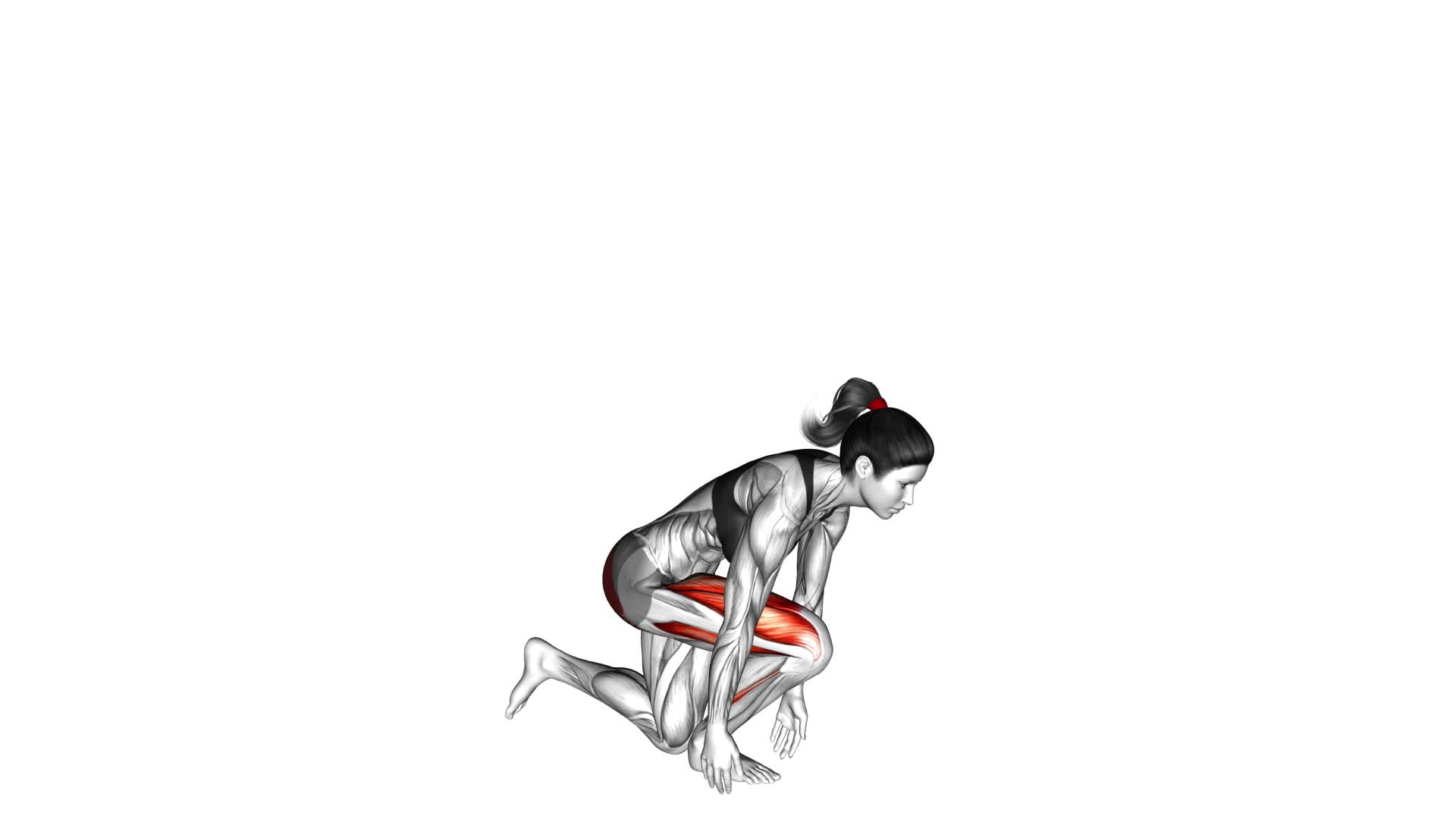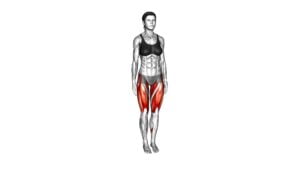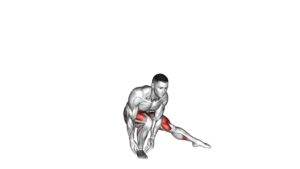Single Leg Heel Touch Squat (female) – Video Exercise Guide & Tips

Are you looking for a challenging lower body exercise that targets your glutes and thighs? Look no further than the Single Leg Heel Touch Squat.
Watch This Exercise Video
This video exercise guide and tips will show you the proper form and technique to get the most out of this exercise. Avoid common mistakes and learn modifications for different fitness levels.
Incorporate the Single Leg Heel Touch Squat into your workout routine and maximize your results.
Key Takeaways
- The Single Leg Heel Touch Squat strengthens glutes, hamstrings, and quadriceps.
- It targets multiple muscle groups simultaneously, leading to stronger and more defined leg muscles.
- Proper form and technique, including maintaining a stable stance and engaging the core, are crucial for avoiding injury and maximizing results.
- Incorporating variations, such as adding weights or performing the exercise on an unstable surface, can enhance the effectiveness of the workout.
Benefits of the Single Leg Heel Touch Squat
One benefit of performing the Single Leg Heel Touch Squat is that it strengthens your glutes, hamstrings, and quadriceps, helping you improve your lower body strength and stability. This exercise targets multiple muscle groups simultaneously, maximizing results and making it an effective workout strategy.
By focusing on one leg at a time, you engage your glutes and hamstrings more intensely, leading to greater muscle activation and growth. Additionally, the quadriceps, located in the front of your thighs, are also heavily engaged during this exercise, leading to stronger and more defined leg muscles.
To perform the Single Leg Heel Touch Squat, start by standing with your feet hip-width apart. Lift one leg off the ground and extend it slightly in front of you. Bend your standing leg and lower your body towards the ground, reaching down with the hand on the same side as your lifted leg to touch your heel. Keep your back straight and your core engaged throughout the movement. Return to the starting position by pushing through your standing leg and repeat on the other side.
Incorporating the Single Leg Heel Touch Squat into your lower body workout routine won't only strengthen your muscles but also challenge your balance and stability. It's a versatile exercise that can be modified to suit your fitness level by adjusting the depth of the squat or using weights.
Proper Form and Technique
To perform the Single Leg Heel Touch Squat with proper form and technique, you need to maintain a stable stance and engage your core throughout the exercise. This exercise is great for improving balance and building leg strength.
Start by standing on one leg and slightly bending your knee. Extend your other leg out in front of you, keeping it straight. As you lower your body into a squat position, reach down with your opposite hand to touch your heel. Keep your back straight and chest lifted throughout the movement.
Push through your standing heel to return to the starting position. Remember to keep your core engaged to maintain stability and control. By focusing on your form and technique, you can maximize the benefits of this exercise.
Now, let's move on to the next section and discuss common mistakes to avoid.
Common Mistakes to Avoid
When performing the single leg heel touch squat, it's important to avoid some common mistakes.
First, ensure that your foot placement is correct by positioning your toes forward and keeping your weight evenly distributed.
Secondly, engage your core throughout the movement to maintain stability and prevent strain on your lower back.
Lastly, make sure to maintain balance by focusing on a fixed point and keeping your body aligned.
Improper Foot Placement
Avoid placing your feet incorrectly during the single leg heel touch squat exercise to maximize effectiveness and prevent injuries. Proper foot placement is crucial for maintaining balance and stability during this exercise.
Here are some common mistakes to avoid:
- Importance of proper footwear: Wearing the right shoes can provide adequate support and cushioning for your feet, reducing the risk of injury.
- Common foot injuries in fitness training: Plantar fasciitis, Achilles tendonitis, and stress fractures are some of the common foot injuries that can occur if your feet aren't properly positioned during exercises.
- Placing too much weight on the toes: This can put excessive strain on the front of your foot and lead to discomfort or injury.
- Not aligning your foot with your knee: Ensure that your foot is in line with your knee to maintain proper form and avoid putting unnecessary stress on your joints.
Lack of Core Engagement
Engage your core properly to maximize the effectiveness of the single leg heel touch squat exercise. Core strengthening is crucial for maintaining balance throughout this exercise.
To engage your core, start by standing tall with your feet hip-width apart. Draw your belly button in towards your spine and engage your abdominal muscles. This will create a stable base and improve your balance.
As you lower into the squat, focus on keeping your core engaged and your torso stable. Avoid arching or rounding your back, as this can put unnecessary strain on your spine.
By maintaining proper core engagement, you won't only strengthen your core muscles but also improve your overall balance.
Transitioning into the next section, let's discuss the importance of not maintaining balance during the single leg heel touch squat exercise.
Not Maintaining Balance
To maintain balance during the single leg heel touch squat exercise, focus on keeping your weight centered and distributed evenly between your supporting foot and the leg in the air. Here are some strategies for improving balance in single leg exercises and addressing common causes of balance issues during squats:
- Engage your core muscles by pulling your belly button in towards your spine.
- Keep your gaze fixed on a focal point in front of you to help stabilize your body.
- Slow down the movement and focus on controlling your balance throughout the exercise.
- Practice balancing exercises, such as standing on one leg or using a stability ball, to strengthen your stabilizer muscles.
By implementing these strategies, you can improve your balance and avoid common mistakes that may hinder your progress in the single leg heel touch squat exercise.
Now, let's move on to the next section where we'll discuss modifications for different fitness levels.
Modifications for Different Fitness Levels
For individuals of varying fitness levels, modifications can be made to the Single Leg Heel Touch Squat exercise to accommodate their specific needs and abilities. Different modifications and fitness progressions can be implemented to ensure a safe and effective workout.
For beginners or individuals with limited lower body strength, a great modification is to perform the exercise while holding onto a stable surface, such as a chair or wall. This provides additional support and balance, making it easier to maintain proper form throughout the movement. As strength and stability improve, gradually reduce reliance on the support until you can perform the exercise unassisted.
To increase the difficulty of the Single Leg Heel Touch Squat and challenge intermediate or advanced fitness levels, there are a few progressions you can try. One option is to add resistance by holding a dumbbell or kettlebell in your hands while performing the exercise. This increases the load on your muscles, making them work harder. Another progression is to elevate your non-working leg on a step or platform, forcing your working leg to bear more weight and increasing the intensity of the exercise.
Incorporating the Single Leg Heel Touch Squat Into Your Workout Routine
To include the Single Leg Heel Touch Squat in your workout routine, start by incorporating it as a lower body strengthening exercise. This exercise targets your glutes, quads, hamstrings, and calves, helping to build strength and stability in your lower body.
Here are four ways you can incorporate the Single Leg Heel Touch Squat into your routine:
- Warm-up: Begin your workout with a few sets of the Single Leg Heel Touch Squat to activate your muscles and prepare them for the workout ahead.
- Superset: Pair the Single Leg Heel Touch Squat with another lower body exercise, such as lunges or step-ups, to create a challenging superset. This will increase the intensity of your workout and maximize your time spent in the gym.
- Circuit Training: Include the Single Leg Heel Touch Squat in a circuit workout that targets different muscle groups. By incorporating single leg exercises like this squat, you can add variety and challenge to your routine.
- Progressive Overload: As you become more comfortable with the Single Leg Heel Touch Squat, gradually increase the weight or resistance. This will help you continue to challenge your muscles and make progress over time.
Incorporating single leg exercises like the Single Leg Heel Touch Squat and variations of squats into your workout routine can enhance your lower body strength, improve balance, and increase overall fitness levels. Give it a try and reap the benefits!
Tips for Maximizing Results
To maximize your results with the Single Leg Heel Touch Squat, focus on maintaining proper form throughout the exercise. Keep your core engaged, chest up, and knees aligned with your toes.
Additionally, incorporate effective workout strategies such as gradually increasing the intensity and incorporating variations to challenge your muscles.
Lastly, prioritize nutrition and recovery by fueling your body with nutritious foods and allowing enough rest between workouts for optimal muscle growth and repair.
Proper Form Techniques
To achieve maximum results, focus on maintaining proper form when performing the Single Leg Heel Touch Squat exercise. Here are some key tips to help you improve stability and maximize muscle activation:
- Balance is crucial: Keep your core engaged and maintain a steady balance throughout the movement. Imagine rooting your standing foot into the ground.
- Control your descent: Lower yourself down slowly and under control, keeping your knee aligned with your toes. This will help activate your glutes and quads effectively.
- Engage your glutes: Squeeze your glutes at the top of the movement to maximize muscle activation and enhance stability.
- Avoid excessive leaning: Keep your upper body upright and avoid leaning forward or backward. This will ensure proper form and target the intended muscle groups.
By focusing on these form techniques, you'll optimize your results and reduce the risk of injury during the Single Leg Heel Touch Squat exercise.
Now, let's move on to effective workout strategies to further enhance your performance.
Effective Workout Strategies
Now let's delve into effective workout strategies to maximize your results and enhance your performance during the Single Leg Heel Touch Squat exercise.
To keep your workouts challenging and engaging, consider incorporating workout variations into your routine. You can try adding weights to increase resistance or perform the exercise on an unstable surface like a balance pad or BOSU ball. This will help target different muscle groups and prevent plateaus.
Additionally, implementing time management strategies can make your workouts more efficient. Plan your workouts in advance, set specific time limits for each exercise, and eliminate distractions to ensure focused and productive sessions.
By following these strategies, you can optimize your training and achieve better results.
Now, let's move on to the next section for nutrition and recovery tips.
Nutrition and Recovery Tips
How can you optimize your nutrition and recovery to maximize your results during the Single Leg Heel Touch Squat exercise? Here are four nutrition tips and recovery strategies to help you achieve the best possible outcome:
- Fuel your body with the right nutrients: Prioritize whole foods that are rich in protein, such as lean meats, eggs, and legumes, to support muscle growth and repair. Incorporate complex carbohydrates like whole grains and fruits to provide sustained energy.
- Hydrate adequately: Drink plenty of water before, during, and after your workout to stay hydrated and facilitate optimal performance. Dehydration can lead to decreased energy levels and impaired recovery.
- Prioritize post-workout nutrition: Consume a combination of protein and carbohydrates within 30 minutes of completing your exercise. This will help replenish glycogen stores and support muscle recovery.
- Allow for proper rest and recovery: Ensure you get enough sleep to allow your body to repair and regenerate. Incorporate active recovery activities like stretching, foam rolling, and light cardio to enhance circulation and reduce muscle soreness.
Frequently Asked Questions
What Are the Potential Benefits of the Single Leg Heel Touch Squat for Improving Balance and Stability?
The single leg heel touch squat can offer several benefits for improving your balance and stability. By focusing on one leg at a time, this exercise helps to strengthen the muscles in your lower body, including the glutes, quadriceps, and calves.
It also challenges your core muscles and improves proprioception, which is your body's awareness of its position in space.
Additionally, this exercise can be modified to accommodate knee and ankle issues, making it accessible for a variety of fitness levels.
Can the Single Leg Heel Touch Squat Help With Strengthening the Muscles in the Lower Body, Such as the Glutes, Quadriceps, and Hamstrings?
Yes, the single leg heel touch squat can definitely help strengthen the muscles in your lower body. By performing this exercise, you target your glutes, quadriceps, and hamstrings, helping to build strength and stability.
To vary the exercise, you can try different single leg heel touch squat variations, such as adding weights or performing it on an unstable surface.
Be aware of common mistakes in the single leg heel touch squat, like leaning too far forward or not engaging your core properly.
Are There Any Specific Tips for Individuals With Knee or Ankle Issues When Performing the Single Leg Heel Touch Squat?
When dealing with knee or ankle issues, it's important to modify the single leg heel touch squat. Here are some tips for you:
- Start by using a chair or wall for support.
- Place your non-working leg close to your working leg for added stability.
- Lower yourself as much as you can comfortably, focusing on proper form and control.
- As you gain strength and stability, you can gradually increase the depth of your squat.
- Remember to listen to your body and stop if you experience any pain or discomfort.
Can the Single Leg Heel Touch Squat Be Performed With Additional Weight or Resistance to Increase the Intensity?
To increase the intensity of the single leg heel touch squat, you can perform it with additional weight or resistance. This will challenge your muscles even more and help you build strength. Holding dumbbells in your hands or using a resistance band around your thighs are great options.
If you're a beginner, start with bodyweight only and focus on mastering the proper form before adding any extra weight. Remember to always listen to your body and go at your own pace.
How Often Should the Single Leg Heel Touch Squat Be Incorporated Into a Workout Routine to See Noticeable Results in Terms of Strength and Muscle Toning?
To see noticeable results in terms of strength and muscle toning, it's important to incorporate the single leg heel touch squat into your workout routine with the right frequency.
The frequency will depend on your fitness goals and current level of fitness. However, a general recommendation is to perform this exercise at least 2-3 times per week.
Consistency is key to seeing noticeable results, so make sure to stick to your routine and challenge yourself as you progress.
Conclusion
Incorporating the single leg heel touch squat into your workout routine can provide numerous benefits, including improved balance, strength, and stability. By maintaining proper form and avoiding common mistakes, you can maximize the effectiveness of this exercise.
Different fitness levels can also be accommodated through modifications. Remember to listen to your body and start with lighter weights or no weights at all if needed.
With consistency and dedication, you can achieve great results with the single leg heel touch squat.

Author
Years ago, the spark of my life’s passion ignited in my mind the moment I stepped into the local gym for the first time. The inaugural bead of perspiration, the initial endeavor, the very first surge of endorphins, and a sense of pride that washed over me post-workout marked the beginning of my deep-seated interest in strength sports, fitness, and sports nutrition. This very curiosity blossomed rapidly into a profound fascination, propelling me to earn a Master’s degree in Physical Education from the Academy of Physical Education in Krakow, followed by a Sports Manager diploma from the Jagiellonian University. My journey of growth led me to gain more specialized qualifications, such as being a certified personal trainer with a focus on sports dietetics, a lifeguard, and an instructor for wellness and corrective gymnastics. Theoretical knowledge paired seamlessly with practical experience, reinforcing my belief that the transformation of individuals under my guidance was also a reflection of my personal growth. This belief holds true even today. Each day, I strive to push the boundaries and explore new realms. These realms gently elevate me to greater heights. The unique combination of passion for my field and the continuous quest for growth fuels my drive to break new ground.







